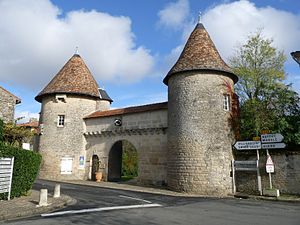Villefagnan
| Villefagnan | ||
|---|---|---|

|
|
|
| region | Nouvelle-Aquitaine | |
| Department | Charente | |
| Arrondissement | Confolens | |
| Canton | Charente North | |
| Community association | Val de Charente | |
| Coordinates | 46 ° 1 ′ N , 0 ° 5 ′ E | |
| height | 88-158 m | |
| surface | 23.65 km 2 | |
| Residents | 999 (January 1, 2017) | |
| Population density | 42 inhabitants / km 2 | |
| Post Code | 16240 | |
| INSEE code | 16409 | |
 Villefagnan - Logis des Tours |
||
Villefagnan ( Occitan : identical) is a place and a community with 999 inhabitants (at January 1, 2017) in western France Charente in the region Nouvelle-Aquitaine . The community consists of several hamlets ( hameaux ) and individual farmsteads .
location
The place Villefagnan is at an altitude of about 120 m above sea level. d. M. in the north of the old cultural landscape of the Angoumois at a short distance from the Deux-Sèvres department . The place is about 51 km (driving distance) in a northerly direction from the city of Angoulême ; to Poitiers is about 77 km in a north-easterly direction. The municipality is located on the Villefagnan plain , a bird sanctuary of the Natura 2000 project . The river Bief crosses the municipality.
Population development
| year | 1800 | 1851 | 1901 | 1954 | 1999 | 2016 |
| Residents | 1615 | 1550 | 1404 | 1017 | 1022 | 1009 |
The continuous decline in population in the 20th century is essentially due to the consequences of the phylloxera crisis in viticulture and the increasing mechanization of agriculture .
economy
The place and its surroundings were dominated by agriculture for centuries; Most of the people lived on the produce of their fields and gardens as self-sufficient ; On the rather barren and stony soils, livestock was raised on a large scale. Craftsmen and small traders also settled in the village. In the late Middle Ages and early modern times, viticulture was promoted, but - after the phylloxera crisis in the late 19th and early 20th centuries - it is no longer important today. Since the 1960s tourism has played a not insignificant role in the economic life of the municipality in the form of renting out holiday homes ( gîtes ).
history
In ancient times, the region belonged to the settlement area of the Celtic pictons , who were subjugated by Caesar during the Gallic War . Gallo-Roman finds (bricks etc.) prove a permanent settlement during this time.
The first mention by name ( Villa Fagna ) comes from the year 855. Until the French Revolution , the church of the village belonged to the diocese of Poitiers ; the bishops owned the Château Lesvescault here , of which the gate of the wall ring is still preserved. In the 17th century, Villefagnan came under the influence of Protestantism . One of the " sons of the city " known worldwide is the tenor Georges Jouatte , born here in 1892, who worked at the Paris Opera House from 1934 to 1946 .
Attractions
- The parish church of Saint-Pierre dates back to the 12th century. After the end of the Hundred Years War (1337-1453), a side aisle was added to the south side of the nave ; In addition, the crossing tower was raised and the buttresses on the outer walls were reinforced.
- Only the gate flanked by two towers remains of the former episcopal castle ( Château Lesvescault ). It was classified as a Monument historique in 1951 .
- The Protestant temple with its two-tower facade was built in 1859; it is the fifth Reformed church in the town and was classified as a monument historique in 1998 .
- The grain hall ( halle aux grains ), completed in 1868, was once the mercantile center of the town.
- outside
- Of the ten windmills ( moulins á vent ) in the area, only one still exists, which was restored at the end of the 20th century and converted into a holiday home ( gîte ).
Web links
- Villefagnan, place - photos + information (French)
- Villefagnan, history - photos + information (French)
- Villefagnan, church - photos + information (French)
Individual evidence
- ↑ Villefagnan - Viticulture
- ↑ Logis des Tours, Villefagnan in the Base Mérimée of the French Ministry of Culture (French)
- ^ Temple, Villefagnan in the Base Mérimée of the French Ministry of Culture (French)

